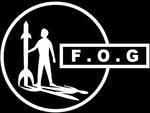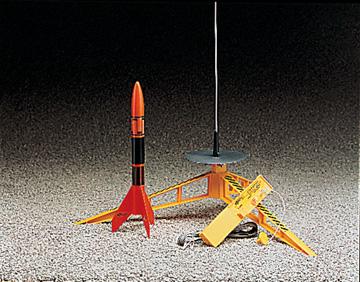





If you've found this website you're well on the way to getting started in model rocketry. This page of the website has been written to answer the types of questions that club members get asked most frequently. If you have a question then email it to the webmaster by clicking HERE.
Is it legal?
Model rocketry is legal in the United Kingdom. The Civil Aviation Authority (CAA) has recognised model rockets as users of airspace and have included them in their regulations. The Health and Safety Executive (HSE) regulate the storage and transportation of model rocket motors. Details of these regulations can be found on the UKRA Website.
Is it safe?
Model rocketry has a good safety record, not only in the UK but throughout the world. All rocketry clubs have a Range Safety Officer (RSO) whose job is to ensure that the safety code is being applied, and to assist rocketeers to launch safely.
How do I start?
A good way to start is to get an Estes Starter Kit from your local model shop, or from one of the vendors on the links page of this site. This will contain a ready-made rocket, launch pad and launch controller. You will need to provide batteries and motors. The contents of the kits are shown in the picture below.
Is it legal?
Model rocketry is legal in the United Kingdom. The Civil Aviation Authority (CAA) has recognised model rockets as users of airspace and have included them in their regulations. The Health and Safety Executive (HSE) regulate the storage and transportation of model rocket motors. Details of these regulations can be found on the UKRA Website.
Is it safe?
Model rocketry has a good safety record, not only in the UK but throughout the world. All rocketry clubs have a Range Safety Officer (RSO) whose job is to ensure that the safety code is being applied, and to assist rocketeers to launch safely.
How do I start?
A good way to start is to get an Estes Starter Kit from your local model shop, or from one of the vendors on the links page of this site. This will contain a ready-made rocket, launch pad and launch controller. You will need to provide batteries and motors. The contents of the kits are shown in the picture below.

Where can I get Insurance?
Join the BMFA. All members of the British Model Flying Association (BMFA) are insured to fly rockets up to G impulse. Details of the cover provided are in the BMFA Handbook.
What do the letters and numbers on motors mean?
Motors are at the heart of this hobby, and understanding what the code on a motor means is very useful. Motors usually have a code stamped on them such as A8-3, C6-7 or D12-0. The letter tells you the impulse of the motor. A class B motor has twice the impulse of a class A motor. It is thus a more powerful motor and contains more propellant. The first number tells you how much thrust the motor will provide, in other words how much "push" it will give the rocket. The final number is the delay time, in seconds, before the motor fires the ejection charge.
A B6-4 motor, for example, will have an impulse of 5 Newton-Seconds, will provide 6 Newtons of thrust, and will fire the ejection charge after the rocket has coasted for 4 seconds.
What are "BP" and "AP" motors?
BP is short for "black powder", which is one of the tow main solid propellants used in model rockets. BP is used in motors up to E impulse. Beyond E impulse black powder becomes very inefficient so Ammonium perchlorate (AP) propellants are used. AP provides three or four times more thrust for each gramme of propellant so it is useful for making lighweight and powerful motors.
What rocket kit should I get first?
Building model rocket kits is a good way of developing knowledge of model rocketry. Most manufacturers classify their kits according to the skill required to make them. A kit at skill level 1 will be a very simple rocket with a few parts. The parts will be pre-cut and will assemble very easily. Skill level 4 and 5 kits have tens or even humdreds of parts, some of which will need preparation, and the kit will require a good understanding of construction techniques, glues, tools and painting.
Most people start at skill level 1 and progress fairly rapidly to skill levels 2 and 3. It's worth spending time at these levels, and building kits from different manufacturers, as this will help to build up a good level of knowledge. s with any hobby, it's always a good idea to learn slowly and make your mistakes on cheap rockets before moving on to more expensinve and powerful rockets.
Companies such as Estes, Semroc, Sunward, Fliskits, Quest and Squirrel Works do a good range of kits at skill level 1 to 3.
How do I progress to more complex rockets?
Once you've got the idea of flying basic rockets, normally called 3FNC (three fins and a nose cone), you'll want to try more interesting and ambitious projects. Some project ideas:
• Clustering two or more motors to provide faster, and more impressive, lift-offs
• Staging rockets so that the upper stage ignites at higher speed. This can attain very high altitudes. Perhaps have a go at one of the altitude records.
• Rocket gliders, where the rocket motor launches a glider
• Making flying scale models of real mssiles, rockets and even aircraft
• Buiding a rocket to carry a payload such as a raw egg (tricky), altimeter or a camera.
• Helicopter recovery, where the parachute is replaced by rotating
blades
• "Oddrocks". This is a class of "rocket" made from unusual objects such as plastic bottles, toilet plungers, or anything else that's vaguely aerodynamic
Can I design my own rockets?
Yes. There is software available to help you to design your own rockets. OpenRocket, Rocksim and SpaceCad will help you to design your own rockets and test how well they fly. There are some good "how to" videos by Tim van Milligan of Rocksim on You Tube. Click HERE to see them.
Are there any good books I can read?
The "Handbook of Model Rocketry" by G Harry Stine is an excellent introduction to the hobby.
Motor Impulse
The total impulse of the motors in a rocket is normally identified by a letter on the motor packaging.
Letter Impulse (Newton Seconds)
A 1.26 - 2.50
B 2.51 - 5.00
C 5.01 - 10.00
D 10.01-20.00
E 20.01 - 40.00
F 40.01 - 80.00
G 80.01 - 160.00
H 160.01 - 320.00
I 320.01 - 640.00
J 640.01 - 1280.00
K 1280.01 - 2560.00
L 2560.01 - 5120.0
M 5120.01 - 10240.00
What are the high power certification levels?
UKRA has a certification scheme for flying high power rockets. This scheme divides rockets into 4 bands, depending on the total impulse of the motors:
- A to G impulse: No certification required.
- H to I impulse: Level 1 certification required
- J to L impulse: Level 2 certification required
- M impulse and higher: Level 3 certification required
Join the BMFA. All members of the British Model Flying Association (BMFA) are insured to fly rockets up to G impulse. Details of the cover provided are in the BMFA Handbook.
What do the letters and numbers on motors mean?
Motors are at the heart of this hobby, and understanding what the code on a motor means is very useful. Motors usually have a code stamped on them such as A8-3, C6-7 or D12-0. The letter tells you the impulse of the motor. A class B motor has twice the impulse of a class A motor. It is thus a more powerful motor and contains more propellant. The first number tells you how much thrust the motor will provide, in other words how much "push" it will give the rocket. The final number is the delay time, in seconds, before the motor fires the ejection charge.
A B6-4 motor, for example, will have an impulse of 5 Newton-Seconds, will provide 6 Newtons of thrust, and will fire the ejection charge after the rocket has coasted for 4 seconds.
What are "BP" and "AP" motors?
BP is short for "black powder", which is one of the tow main solid propellants used in model rockets. BP is used in motors up to E impulse. Beyond E impulse black powder becomes very inefficient so Ammonium perchlorate (AP) propellants are used. AP provides three or four times more thrust for each gramme of propellant so it is useful for making lighweight and powerful motors.
What rocket kit should I get first?
Building model rocket kits is a good way of developing knowledge of model rocketry. Most manufacturers classify their kits according to the skill required to make them. A kit at skill level 1 will be a very simple rocket with a few parts. The parts will be pre-cut and will assemble very easily. Skill level 4 and 5 kits have tens or even humdreds of parts, some of which will need preparation, and the kit will require a good understanding of construction techniques, glues, tools and painting.
Most people start at skill level 1 and progress fairly rapidly to skill levels 2 and 3. It's worth spending time at these levels, and building kits from different manufacturers, as this will help to build up a good level of knowledge. s with any hobby, it's always a good idea to learn slowly and make your mistakes on cheap rockets before moving on to more expensinve and powerful rockets.
Companies such as Estes, Semroc, Sunward, Fliskits, Quest and Squirrel Works do a good range of kits at skill level 1 to 3.
How do I progress to more complex rockets?
Once you've got the idea of flying basic rockets, normally called 3FNC (three fins and a nose cone), you'll want to try more interesting and ambitious projects. Some project ideas:
• Clustering two or more motors to provide faster, and more impressive, lift-offs
• Staging rockets so that the upper stage ignites at higher speed. This can attain very high altitudes. Perhaps have a go at one of the altitude records.
• Rocket gliders, where the rocket motor launches a glider
• Making flying scale models of real mssiles, rockets and even aircraft
• Buiding a rocket to carry a payload such as a raw egg (tricky), altimeter or a camera.
• Helicopter recovery, where the parachute is replaced by rotating
blades
• "Oddrocks". This is a class of "rocket" made from unusual objects such as plastic bottles, toilet plungers, or anything else that's vaguely aerodynamic
Can I design my own rockets?
Yes. There is software available to help you to design your own rockets. OpenRocket, Rocksim and SpaceCad will help you to design your own rockets and test how well they fly. There are some good "how to" videos by Tim van Milligan of Rocksim on You Tube. Click HERE to see them.
Are there any good books I can read?
The "Handbook of Model Rocketry" by G Harry Stine is an excellent introduction to the hobby.
Motor Impulse
The total impulse of the motors in a rocket is normally identified by a letter on the motor packaging.
Letter Impulse (Newton Seconds)
A 1.26 - 2.50
B 2.51 - 5.00
C 5.01 - 10.00
D 10.01-20.00
E 20.01 - 40.00
F 40.01 - 80.00
G 80.01 - 160.00
H 160.01 - 320.00
I 320.01 - 640.00
J 640.01 - 1280.00
K 1280.01 - 2560.00
L 2560.01 - 5120.0
M 5120.01 - 10240.00
What are the high power certification levels?
UKRA has a certification scheme for flying high power rockets. This scheme divides rockets into 4 bands, depending on the total impulse of the motors:
- A to G impulse: No certification required.
- H to I impulse: Level 1 certification required
- J to L impulse: Level 2 certification required
- M impulse and higher: Level 3 certification required
© FOG 2018 All rights reserved

































